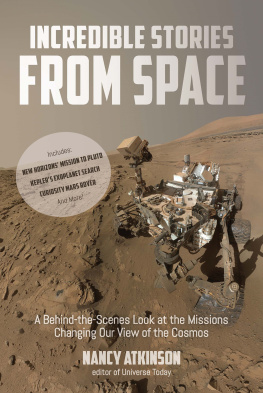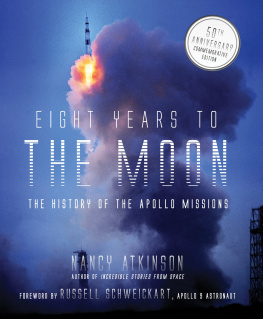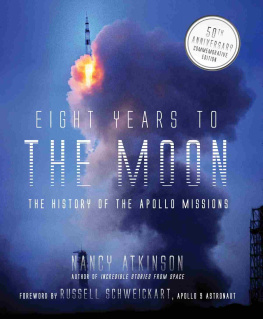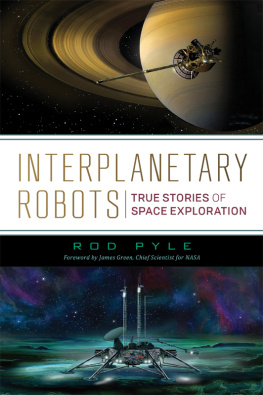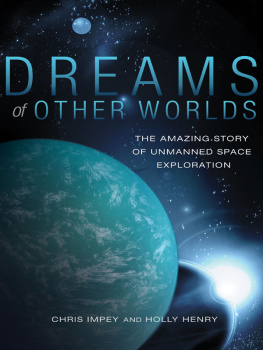Contents
Guide
INCREDIBLE STORIES
FROM SPACE
A Behind-the-Scenes Look at the Missions Changing Our View of the Cosmos
NANCY ATKINSON
editor of Universe Today

The author and publisher have provided this e-book to you for your personal use only. You may not make this e-book publicly available in any way. Copyright infringement is against the law. If you believe the copy of this e-book you are reading infringes on the authors copyright, please notify the publisher at: http://us.macmillanusa.com/piracy.
TO RICK, ALWAYS
Ive had the privilege of working side-by-side with Nancy Atkinson for over a decade now. Incredible Stories from Space demonstrates the depth of her knowledge and easy, accessible writing style.
Fraser Cain, Publisher, Universe Today
Space exploration represents the best of humanity, and it seems only right that we should chronicle our brave space robots silicon sacrifices and the passionate scientists and engineers behind them. To do this we need an expert storyteller, one who has reported for years on their voyages. Nancy is that storyteller and inIncredible Stories from Spaceshe not only gives us a brilliant behind-the-scenes glimpse into what these amazing missions mean to her, she beautifully describes the historic science discoveries that are being made, right now, by our selfless robots journeying into the solar system and beyond.
Dr. Ian ONeill, Senior Producer for Space, Discovery News
The latest generation of space explorers arent being born, they are being built. Nancy Atkinson introduces you to a handful of these rising stars, and tells their stories through detailed interviews and an engrossing personal narrative. Make her passion your own, and travel between the planets inside these pages.
Dr. Pamela Gay, Astronomy Cast

The Atlas V rocket carrying the Solar Dynamics Observatory begins rolling out to the launch pad at Cape Canaveral Air Force Station from a thirty story gantry called the Vertical Integration Facility. Credit: NASA
On February 11, 2010, I stood alongside several scientists as we watched a rocket thunder off the launchpad at Kennedy Space Center (KSC) in Florida. Nestled inside the rocket was a robotic spacecraft these scientists had spent most of their careers working to make a reality.
For me, experiencing a launch up close and in person was something I had been anticipating for several months, although there was really no way of knowing ahead of time how indescribably exhilarating the launch experience would be. I highly recommend it for everyone.
Half a year earlier, I had begun making preparations to attend another launch at KSC, the STS-130 mission for space shuttle Endeavour to send six astronauts to install two new components on the International Space Station. Since NASA had announced in 2004 that the space shuttle program would be ending by 2011, I knew I wanted to be on hand for some of the final missions launched aboard this magnificent and storied spacecraft. After all, I was a journalist who specialized in space exploration and astronomy: what could be more poignant than to report on the end of an era in spaceflight?
By analyzing launch schedules, however, I soon realized I could maximize my trip and see additional launches by simply extending my stay. Plus, since I was living in Illinois at the time, the concept of spending a few weeks in Florida during the winter seemed like a really great idea.
My time on the Space Coast in 2010 ended up being a bucket list type of trip, where I not only had the opportunity to witness four different launches (two space shuttles and two robotic spacecraft), but also visit NASA facilities, get behind-the-scenes tours and insights and meet and interview dozens of astronauts, scientists, engineers and NASA officials. A highlight was the once-in-a-lifetime opportunity to stand directly on historic Launch Pad 39A at KSC, right underneath the massive space shuttle Discovery, poised to launch on its penultimate flight.
While human spaceflight is certainly compellingand it has always been a big part of my reporting careerthere is something about unmanned robotic spacecraft that has always tugged at my heart. These machines are our emissaries out into the cosmos, flung to faraway places that humans cant yet visit. I grew up hearing about spacecraft like Mariner, Viking and Voyager boldly going on some of the first-ever deep space missions and making monumental discoveries that changed our view of the solar system. They showed us worlds we previously could only dream about and artists could only imagine.
Now, every day we receive real, stunning images direct from our spacecraft stationed at other planets, dwarf planets, asteroids, comets and moons in our cosmic neighborhood. Whatever it takes to make it work, robotic spacecraft have done flybys, orbited, soft-landed, crashed into and roved about on various places in our solar system, all in the name of science and exploration. Weve also launched big telescopes into space, putting them high above the murkiness of Earths atmosphere to get a clear view of stars, distant galaxies and even other solar systems completely different from our own. These missions are showing us we live in an amazing, breathtaking universe.
Despite the fact that these are unmanned machinesmade just of metal and circuitryout there exploring the cosmos, there is still a human element to it all. Humans yearn to know the answers to questions about the heavens, and so we devise and build spacecraft. Human ingenuity calculates trajectories and ephemerides (computations of exactly where planetary bodies and spacecraft are at a given time) to set the spacecraft on course across interplanetary distances. The investigative human mind analyzes the data to make conclusions and discoveries. And even those of us humans who arent rocket scientists are awed and amazed at the intrinsically beautiful images from space and wonder at marvelous new findings from faraway places. These machines allow us to explore the cosmos, all from the comfort of our home planet.
But getting a robotic spacecraft on a mission to space is no easy task.
The usual process is that astronomers and planetary scientists can toil for years in their field of study and somewhere along the line an unsolved question or deep mystery sparks an idea for an instrument, or even a full-up spacecraft with numerous instruments, to study the mystery. Preliminary mission concepts and schematics are drawn up with potential coinvestigators.
Then the scientists need to wait until a space agency like NASA (the National Aeronautics and Space Administration in the United States), ESA (European Space Agency), JAXA (Japans space agency) or ISRO (the space agency in India) has what is called an Announcement of Opportunity (AO), where the space agency puts out a call for proposals for missions to space. Usually, however, the space agency is looking only for a certain kind of mission, so if the type of mission the scientists want doesnt fall under this specific AO (yes, space exploration is full of acronyms) they need to wait longer until the right opportunity comes along.

